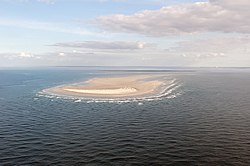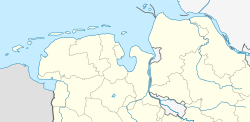Balmoral (ship, 1944)
|
The high sand Mellumplate with the remains of the wreck in the center of the picture
|
||||||||||||||||||
|
||||||||||||||||||
|
||||||||||||||||||
|
||||||||||||||||||
The Balmoral was a Liberian cargo ship that was stranded on March 12, 1967 between the Outer Jade and Outer Weser and could no longer be saved.
history
The necklace of the type Icemaid belonged to the group of the empire ship . The ship was under the hull number 454 of the Grangemouth Dockyard Company built and ran on 25 April 1944 by the stack . The ship, powered by a triple expansion steam engine, was put into service in July 1944 as the Empire Peggotty for the Ministry of War Transport in London. The management was initially carried out by Stephenson, Clarke and Associated Companies, also based in London, and from November 4, 1945 by Harries Brothers and Company from Swansea . On May 7, 1946, Harries Brothers bought the ship and renamed it Glanowen . In 1964 the Glanowen was sold to Wiliam Dickinson and Company in Newcastle-upon-Tyne and in 1965 the shipping company Transocean Maritima Samuel M. Bull from Madrid acquired the ship and registered it as Balmoral for the Liberian Balmoral Shipping Corporation. Transocean Maritima used the Balmoral until the accident .
Average
The Balmoral was on its way from Gent to Bremen and drove in ballast . Of Norddeich Radio the message was received, the that Weserlotse because of the Northwest storming of the inside position near the Buoy "G" (until 1976 were starboard tons of letters referred to) had withdrawn. The Balmoral's captain, who was ignorant of the location , headed for buoy “G” in the outer jade. When he had reached this position on the stormy night of March 12, 1967, he found that the pilot he expected was much further to the east, namely at buoy “G” in the Outer Weser. The Balmoral then connected to the pilot with the signal lamp . A few minutes after the pilot's request to turn back, the ship had the first grounding at 01:15. After that, the Balmoral was driven further and further onto the high sand of the Mellumplate by the storm and the tidal currents . The stranding initially posed no danger to the crew.
The recovery started in the next few days . However, the tug Goliath broke the cables in a storm on March 16 . The rescue cruiser HH Meier then took over the ten-man crew, only the captain and a few officers remained on board, but they too left the distressed vessel on March 20. After the ship broke in two on April 5, only the forecastle could be salvaged and towed to the scrapping yard . The stern remained on the Mellumplate as a visible wreck.
Web links
- SS Balmoral (stern section). Wrecksite, March 31, 2017, accessed November 12, 2018 .
- Theo Kruse: Five young sailors from the pirate voyage. Nordwest-Zeitung , May 13, 2017, accessed on November 12, 2018 .
- Image of the icy wreck. Federal Institute for Hydraulic Engineering , January 16, 1987, accessed on November 12, 2018 .

